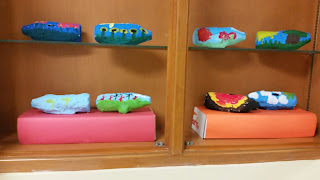A big focus for my 2nd graders is community. They study it all year round and I used this to inspire me to do a community project. And who better to base that project on then Faith Ringgold?
So started by reading them Tar Beach. One of her books about where she lived and what was around her community. (can you feel the connections?) Next we looked at starting our background because we learned that Ringgold starts with doing her background first. 

So I took this as a way to talk about science and how the moon reflects light in the night sky. We had a great discussion about why this happens and what colors we see in the night sky. To recreate this appearance. We explored tint and tone in a sky painting of the full moon. The students had a lot of fun seeing the transition of colors with just a little black.
Another part we did was we planned what to include in our community. They got out their sketchbooks and drew and discussed. But part of this day was also creating our own scratch art paper to use for the boarder later on. We used oil pastel on heavy paper then covered with black acrylic paint. (I normally use tempera with my students and a few actually noticed this paint was different.)
They had a hoot with it when I told them "just cover that paper with oil pastel. Does not matter color or design, just COVER!"
So the fun part that I am changing for next year. The community part collage part. I don't know if I over reached or the students didn't quiet get it but my goal was to have them create 8 buildings with overlapping with scrap paper. Now, the mistake falls in the overlapping of the buildings and number. I would say about 50% of them got the overlapping while others had buildings flying in the sky. So learned to either go over more or less buildings and just do a front simple few.
BUT the collage board part was fun. We used wall paper, fabric and then those pieces of scratch art paper to create the border. I think for next year I will just make smaller pieces of the wall paper and fabric because a few fell off. Also good glue is really important here.
Overall I feel this was still a successful project that I learned from to improve on next year. Their classroom teacher loved it so that is good for me.










































